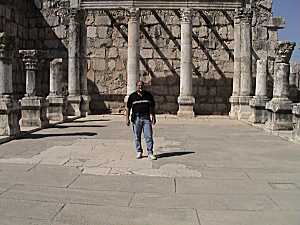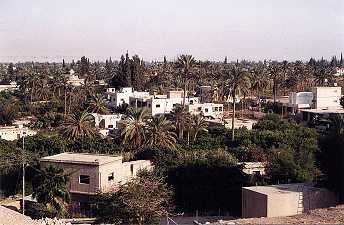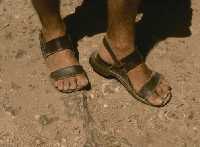Please note:
Over the Next three weeks, Tim will be over in the Middle East. He is leading a Biblical Study Journey and is taking a film crew to capture some of the sites in the Land of the Bible to be used with his Word Among Us Bible Study program. The devotions while he is gone will focus on the Land of the Bible. We hope in some small way you can share in the Journey and be enriched with your walk with Jesus.
Day 4
Capernaum
Turning around, Jesus saw them following and asked, "What do you want?" They said, "Rabbi" (which means Teacher), "where are you staying?" "Come," he replied, "and you will see." So they went and saw where he was staying, and spent that day with him. It was about the tenth hour. John 1:38-39
(click on the photo below for a LARGER view)

Capernaum served as a military post for the Romans; it stood along the busy international trade route called the Via Maris (Way of the Sea).
The prophet Isaiah predicted that the Messiah would live by “the way to the sea,” (Isa. 9:1) and Jesus fulfilled this prophecy by living in Capernaum (Matt. 4:13—16). People from around the world could hear Jesus’ message as they traveled on the Via Maris.
Many people living in Capernaum were tektons, people who worked with stones. Once a volcanic lake, the Sea of Galilee left large deposits of volcanic rock, or basalt, in the surrounding area. Jesus was probably a tekton by trade, and his hometown of Capernaum was known for their production of basalt food processing implements.
If Jesus can be said to have had a home after he left Nazareth at the beginning of his “public life,” it would have to be Capernaum, a fishing town at the northern edge of the lake. The area was home to a variety of people, from religious zealots to pagans, and from devout to secular Jews. Jesus brought his life-changing message to them all.
Here the brawny fishermen, Peter, Andrew, James and John heard the call to follow him (Matthew 4:18-22). The miracles Jesus worked here seem to have been numerous. We remember especially the curing of the Roman centurion’s servant (Luke 7:5-10) and that heartrending scene when He raised the daughter of Jairus, a ruler of the local synagogue, from the dead (Luke 8:40-56).
Boats still launch from Tiberias and put in at the pier at Capernaum. How many times did Jesus and his fishermen come ashore from their boats here and receive the hospitality of Peter’s family?
In ancient times, an octagonal shrine was built over the place and many early pious inscriptions were found here. As a result, we have a good idea that this is where Peter lived and where Jesus healed Peter’s mother-in-law. (Peter never thanked Jesus for that one!) In fact, 131 first-century inscriptions were found here. On these reconstructed plaster fragments, the names of Jesus and Peter were frequently mentioned. They indicate that this house was already revered as the “House of Peter the Apostle” (Luke 4:38-41; Matthew 8:14-17 and Mark 1:29-31).
The beautiful Capernaum synagogue that we can see just beyond the “Octagon of St. Peter” was built only at the end of the fourth century. But in all probability, it was constructed over the earlier synagogue where Jesus “taught them with authority” (Mark 1:21-22).
The ruins of Capernaum have been in the control of the Franciscans for over ninety years. The Franciscans have promoted scholarly study of the remains and have themselves conducted important excavations. But much of the original town still lies buried beneath the dirt and grass.
Even today, beautiful stone fragments of carvings, old olive presses, the great trees and flowers cascading over the walls help make this a place for tranquil reflection. When a breeze comes off the lake, it is not difficult to picture the ancient fishermen’s boats. Along the shoreline, one can almost hear them ask Jesus: “Where do you live?” “Come and see,” he answered (John 1:39).
Prayer
Jesus, you found your apostles in the humble fishermen of this town. They had little education, no sophistication, and few pretensions. But you chose them. You called them from their boats and nets, giving them the strength they would need to live and die for you. We have also heard you call us, Lord. Like the fishermen of Capernaum, we are also attached to our “boats and nets,” our familiar lifestyles. We do not leave them easily. We need courage, Master. We need faith to believe that you can use the likes of us in your holy work. Amen
Did someone send you this Devotion? Would you like to receive future ones directly?
Click here to subscribe. While in the Middle East for a Biblical Study Journey with fellow Word Among Us Students, a 5-person crew is filming and taking pictures of the various sites. This vibrant photographic material will be incorporated into next year's Word Among Us classes.
Want to learn more about the Bible Jesus used – The Old Testament – and the Bible Jesus taught? Enroll today in Word Among Us – Cover to Cover study of the Bible starting in Genesis and going through Revelation including the inter - testamental period, using history and archeology and Biblical culture to make the text alive - taught by Tim Hetzner.
Class sites are across the USA. Click here for more information.
 Jericho has a fascinating location and history. Jericho stood by a mountain pass near the northern end of the Dead Sea. As one of the few gateways into the Judean Mountains, Jericho was a natural place for the Israelites to enter the Promised Land. After crossing the Jordan, it was the first city they defeated.
Jericho has a fascinating location and history. Jericho stood by a mountain pass near the northern end of the Dead Sea. As one of the few gateways into the Judean Mountains, Jericho was a natural place for the Israelites to enter the Promised Land. After crossing the Jordan, it was the first city they defeated.

 "Dear woman, why do you involve me?" Jesus replied. "My time has not yet come." His mother said to the servants, "Do whatever he tells you." Nearby stood six stone water jars, the kind used by the Jews for ceremonial washing, each holding from twenty to thirty gallons. Jesus said to the servants, "Fill the jars with water"; so they filled them to the brim. Then he told them, "Now draw some out and take it to the master of the banquet." They did so, and the master of the banquet tasted the water that had been turned into wine. He did not realize where it had come from, though the servants who had drawn the water knew. Then he called the bridegroom aside and said, "Everyone brings out the choice wine first and then the cheaper wine after the guests have had too much to drink; but you have saved the best till now." This, the first of his miraculous signs, Jesus performed at Cana in Galilee. He thus revealed his glory, and his disciples put their faith in him. John 2:1-11
"Dear woman, why do you involve me?" Jesus replied. "My time has not yet come." His mother said to the servants, "Do whatever he tells you." Nearby stood six stone water jars, the kind used by the Jews for ceremonial washing, each holding from twenty to thirty gallons. Jesus said to the servants, "Fill the jars with water"; so they filled them to the brim. Then he told them, "Now draw some out and take it to the master of the banquet." They did so, and the master of the banquet tasted the water that had been turned into wine. He did not realize where it had come from, though the servants who had drawn the water knew. Then he called the bridegroom aside and said, "Everyone brings out the choice wine first and then the cheaper wine after the guests have had too much to drink; but you have saved the best till now." This, the first of his miraculous signs, Jesus performed at Cana in Galilee. He thus revealed his glory, and his disciples put their faith in him. John 2:1-11 Throughout the history of Christianity the most popular place of pilgrimage has been the Holy Land and the sites made sacred by their association with Jesus and his first disciples. Indeed, the Holy Land has been close to the heart of our Jewish and Muslim brothers and sisters as well. There has always been a persistent desire to visit Jerusalem and the other holy places of pilgrimage.
Throughout the history of Christianity the most popular place of pilgrimage has been the Holy Land and the sites made sacred by their association with Jesus and his first disciples. Indeed, the Holy Land has been close to the heart of our Jewish and Muslim brothers and sisters as well. There has always been a persistent desire to visit Jerusalem and the other holy places of pilgrimage.